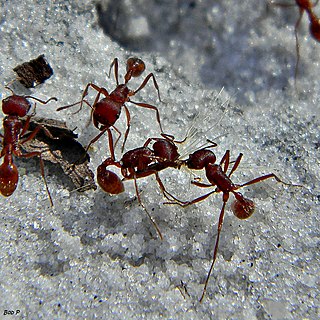
Harvester ant is a common name for any of the species or genera of ants that collect seeds, or mushrooms as in the case of Euprenolepis procera, which are stored in the nest in communal chambers called granaries. They are also referred to as agricultural ants. Seed harvesting by some desert ants is an adaptation to the lack of typical ant resources such as prey or honeydew from hemipterans. Harvester ants increase seed dispersal and protection, and provide nutrients that increase seedling survival of the desert plants. In addition, ants provide soil aeration through the creation of galleries and chambers, mix deep and upper layers of soil, and incorporate organic refuse into the soil.

Phragmosis is any method by which an animal defends itself in its burrow, by using its own body as a barrier. This term was originally coined by W.M. Wheeler (1927), while describing the defensive technique exhibited by insects. Wheeler observed the positioning of specially modified body structures to block nest entrances, as exhibited in various insect species. The term phragmosis has since been further extended beyond just insects.

Crematogastrini is a tribe of myrmicine ants with 64 genera and 8 fossil genera.

Carebara diversa is a species of marauder ant widely distributed throughout Asia.
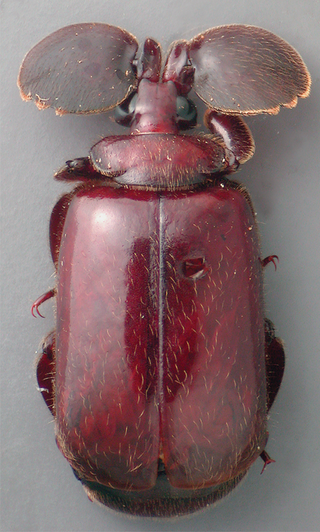
Platyrhopalopsis is a genus of flanged-bombardier beetles in the family Carabidae. They are found, as in others of the group, within ant nests, in the Indo-Malayan region. Adults are rarely seen except at lights. The flat terminal segment of the antenna is thought, based on studies of pupal development, to be formed by the fusion of multiple antennomere segments. The genus, placed by some in the tribe Platyrhopalina, includes the following three species:

Carebara is a genus of ants in the subfamily Myrmicinae. It is one of the largest myrmicine genera with more than 200 species distributed worldwide in the tropics and the Afrotropical region. Many of them are very tiny cryptic soil and leaf-litter inhabitants. They nest in rotten wood to which the bark is still adherent in the Afrotropical region, or may be lestobiotic nesting near other ant species. Some species are known to exist parasitically within termite nests. Little is known about the biology of the genus, but they are notable for the vast difference in size between queens and workers.
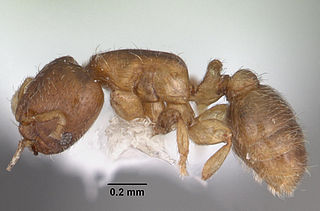
Rhopalomastix is a genus of ants in the subfamily Myrmicinae. It is restricted to the Oriental and Indo-Australian regions, where the ants nest under the bark of living trees.
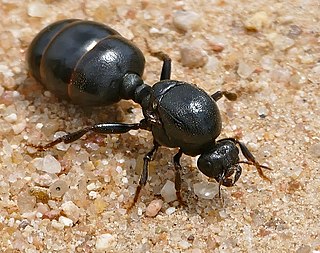
Carebara vidua is a species of ant in the subfamily Myrmicinae. It is currently listed as endangered because it is overly consumed for protein and used for medicine.
Carebara bruni is a species of ant in the subfamily Myrmicinae. It is found in Sri Lanka and China.
Carebara ceylonensis is a species of ant in the subfamily Formicinae. It is found in Sri Lanka.
Carebara deponens is a species of ant in the subfamily Formicinae. It is found in Sri Lanka.
Carebara nana is a species of ant in the subfamily Formicinae, first described in 1863 by Julius Roger as Pheidologeton nanus. It is found in Sri Lanka.
Carebara pygmaea is a species of ant in the subfamily Formicinae. It is found in Sri Lanka, Borneo, Indonesia, Philippines.
Carebara sinhala is a species of ant in the subfamily Formicinae. It is found in Sri Lanka.
Rhopalomastix escherichi is a species of ant of the subfamily Myrmicinae that can be found in Sri Lanka.
Vollenhovia escherichi is a species of ant in the subfamily Myrmicinae. It is found in Sri Lanka.
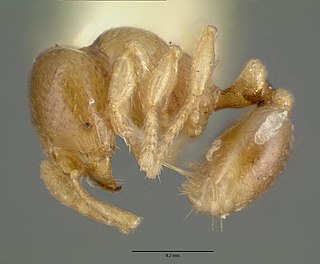
Carebara armata is a species of ant from the subfamily Myrmicinae. The scientific name of this species was first published in 1948 by Horace Donisthorpe.

Carebara castanea is a species of ant from the Myrmicinae subfamily. The scientific name of this species was first published in 1858 by Smith. It is found in Thailand, Laos, and China.

Platyrhopalopsis melleii is a species of ant-nest or flanged bombardier beetle found in southern India. They live inside the nests of ants of the genus Carebara and adults are only rarely seen in the open, most often at night when they get attracted to lights.









